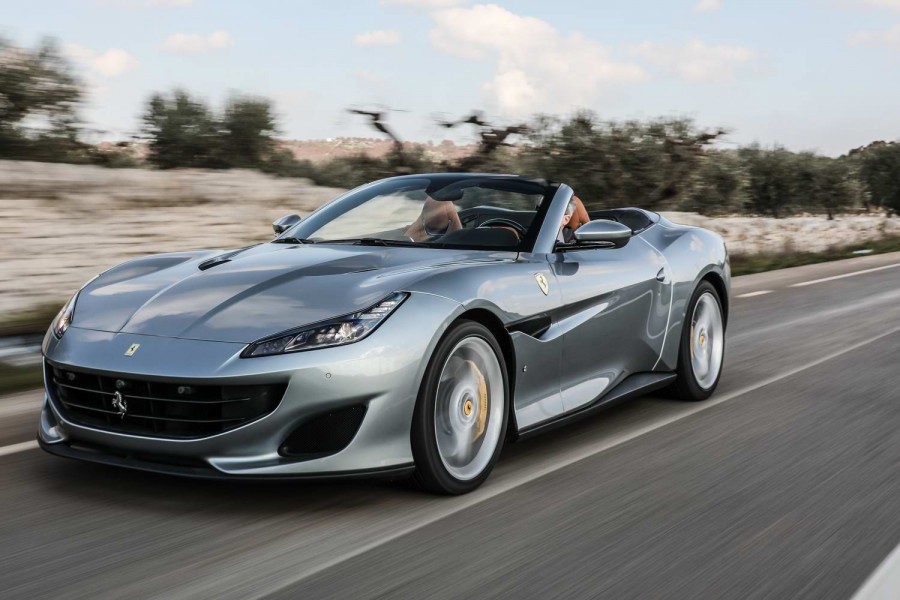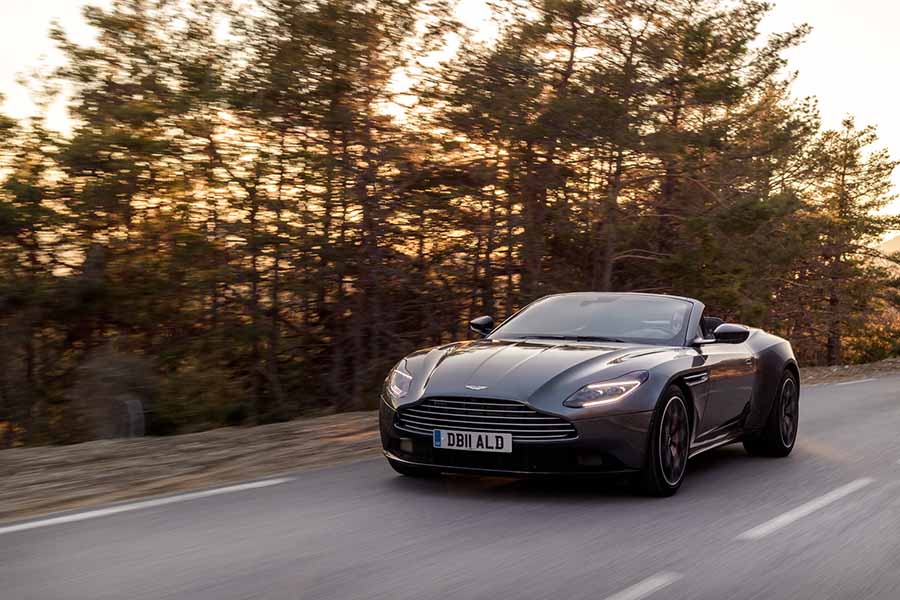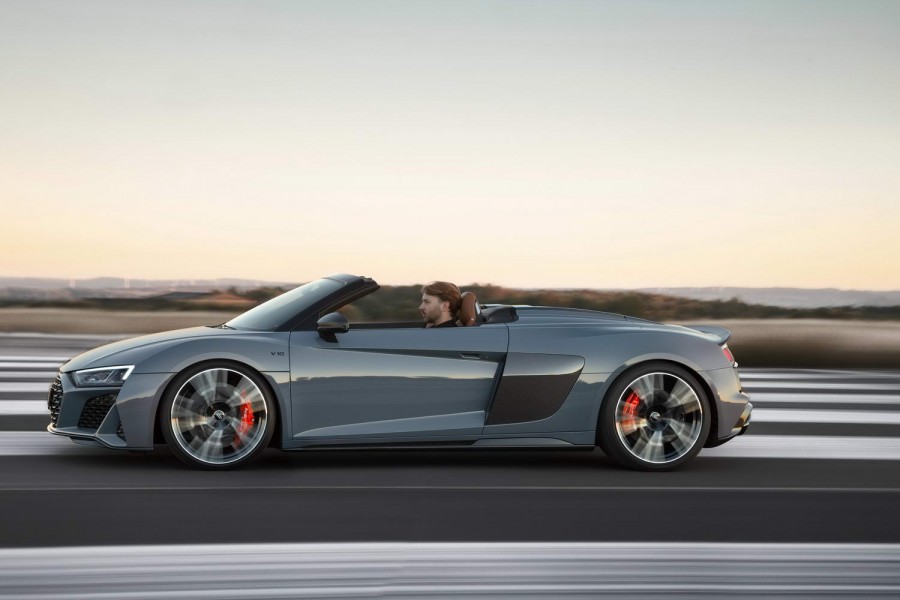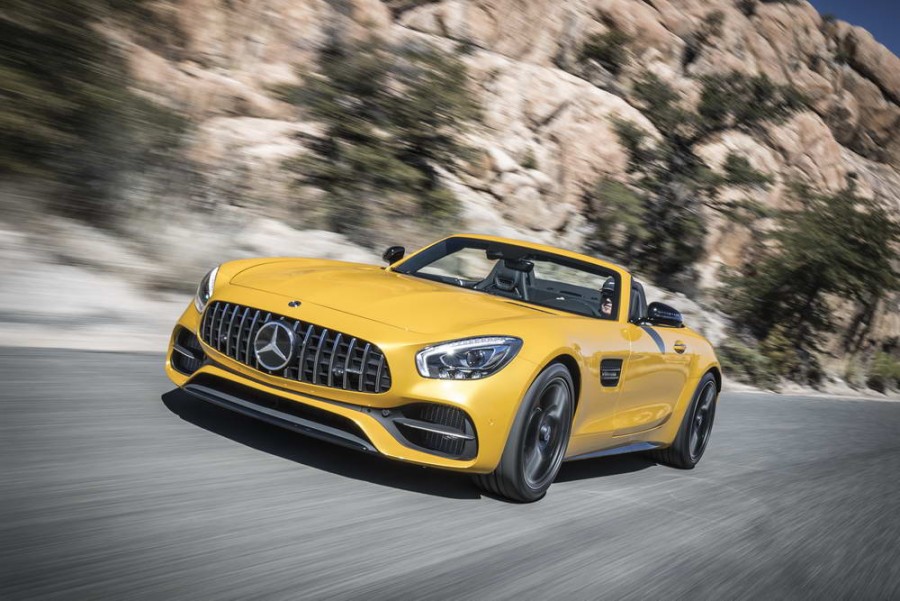Ferrari eradicates memories of the underwhelming California (and its later T version) with the talented and attractive Portofino, which represents a superb entry point to ownership of a modern Prancing Horse.
In the metal
Where the California predecessor was always an awkward-looking thing, the Ferrari Portofino is much more pleasing on the eye. It's not aesthetically perfect and it's not Ferrari's finest-ever piece of design (although, given this company's astonishing back-catalogue of stunners, that's not exactly surprising), but it carries off being a 2+2 convertible with a retractable hard-top (RHT) with an elegant proportionality that's most enticing. Like many a more laid-back Ferrari of the past, the Portofino's lines suit quieter, more subdued colours, like dark blue, black and grey, rather than the obvious red or white, but there's no way you could accuse the Ferrari of being ugly whatever shade it is painted in.
Inside, it's excellent. A new interface sees a sharply resolved and fast-responding 10.25-inch touchscreen dominating the dashboard, while the quality of the leather, fixtures and fittings used is top-notch. The seats are also magnificent, offering great comfort and hold, and they're adjustable right to the floor - so you can sit peeping out over the Ferrari's voluptuous, twin-vented nose, heightening anticipation levels to fever pitch before you've so much as moved an inch in it. Rear-seat space has increased 50mm, but the Portofino really is a strict 2+2; think of the rear pews as extra storage capacity, on top of a surprisingly decent boot out the back. Which is, obviously, somewhat reduced when the roof is dropped away - and you can do this on the move at up to 40km/h, in just 14 seconds, by the way.
Overall, it's a great cabin, although it'll take some familiarisation with the steering wheel switchgear if you've never been in a Ferrari before - the brand's focus on 'keeping your hands on the wheel' is admirable and it makes for delectable touches like the little red Manettino dial for the Portofino's driving modes, but you need to constantly remember the indicator switches are up on the side spokes, rather than a column stalk to one side, while flashing your headlights involves pulling a rocker to the left of the boss towards you. Also, the wheel itself is a bit on the large side for our liking. It's designed that way so you can see the digital instrument cluster behind clearly. A minor observation, this, and one that is offset by the glorious gear shift paddles residing behind the wheel's rim; they're fantastic.
Driving it
Critics of the California said it had gone too soft, too far away from Ferrari's sports car ethos to be acceptable. So if you're going to get on with the Portofino, you must remember that it's still not supposed to be a dynamic rival for the brand's mid-engined V8s, or the big V12 super- and hypercars. It's a front-engined, rear-driven, open-top GT that just so happens to wear a Ferrari badge.
Not, though, that the Portofino is in any way lacklustre. If anything, of all the exotic GTs with a sporting bent, this is the one that is closest to an out-and-out sports car. When you look through the technical make-up of the Portofino, it becomes clear why. Essentially, under the skin, it's a California T with the Handling Speciale pack; but it has the software control systems, to manage all of the steering and the throttle response and the dampers and the gearbox, from the latest range of mid-engined V8s, like the 488 GTB. It's also lighter than the California T, clocking in at 1,664kg all-in. It has a stiffer body than the California T, this being nowhere more evident than in the A-pillar construction - for the California, the A-pillar was made of 21 separate components; for the Portofino, it's built from just two, vastly improving rigidity at the point the doors mount to the rest of the frame.
And how can you possibly be condescending about a supposedly 'baby' Ferrari that packs a 600hp/760Nm wallop, enough to propel it to 100km/h from a standstill in 3.5 seconds and on to a top speed north of the magic 320km/h barrier? Seriously, that power figure is way in advance of what the late '90s entry-level Ferrari, the F355 (380hp), possessed. It even eclipses the 478hp legend that is the F40. Crikey, it's not far off what the Enzo hypercar (660hp) of 2002 churned out.
All of which means the Portofino is every bit as fast and exhilarating and noisy as you could wish of a V8 Ferrari with an open roof. Its 3.9-litre biturbo barks into life on the starter and settles into a serrated idle, and as you move off the exhausts quickly come into play. It's quite a tailpipe-dominated soundtrack on the Portofino, with only a brief section of the sweep of tachometer (between about 4,000- and 5,000rpm) being the point where you can hear the classic flat-plane crank Ferrari V8 yowl, but it is muscular and aggressive in tone at low revs, before exploding into a furious yell as you home in on the 7,500rpm limiter.
Oh, and it's quick. Ridiculously rabid, in fact, and so eager to break traction is the Portofino that it will wiggle the back end in second gear with the traction control fully engaged if you decide to unleash the full force of the motor. Pulling strongly in a higher gear from lower down the engine's performance bracket and yet equally happy to zing out to its rev limiter with a crisp alacrity, this is a gem of a powerplant that results in one rapid car and one seriously fast Ferrari.
Nevertheless, the handling is the showpiece. Cornering flat, finding massive traction, darting into corners with a fervour that's eye-opening... the Portofino feels anything but the grand tourer. You can get it flowing on the midrange, never fully opening the taps nor leaning hard on the standard-fit carbon-ceramic brakes, pouring it into corners and easing out the other side, and it will make most other cars on the road look like they're standing still. Or you can work it as hard as you dare and revel in a rewarding chassis, but - let's be honest - once you're past second gear, to do this in a 600hp Ferrari you're going to be breaking the law. Good news, then; the Portofino fulfils its GT brief equally beautifully, because it will lope along in seventh gear on the motorway at around 110km/h in fantastic comfort. OK, there's a bit more tyre roar than you might expect and the ride on the two-stage 'Magneride' dampers (a cost option) always stays on the firmer side of 'wafting', but it's very assured as a cruiser and with the hood down, occupant buffeting is kept to a minimum.
There are, regrettably, one or two tiny niggles that keep the Portofino from true greatness. The first is the steering, which is hyperactive and overly light - a combination that means you'll be constantly winding lock off as you throw it through your first few corners. Ferrari is proud of the immediacy of the response, saying that on any racetrack in the world, you'll never need more than half-lock to get around a corner - meaning that, once again, you never have to take your hands from the quarter-to-three position. This is great... but the Portofino is hardly going to be the first choice for anyone as a track car. As its remit is mainly on-the-road driving, maybe a slightly more relaxed steering rack with a touch more weight would have been preferable, keep the razor-sharp set-up for the likes of the 488 Pista.
The other is the odd seven-speed transmission. Don't misconstrue us, it's a very good gearbox, slushing shifts in auto mode nicely and responding well to clicks of the paddle shifts, your only means of controlling it manually (the Portofino doesn't have a gear lever, instead favouring a button-shift mechanism on the centre console). But in Sport mode, it really bangs each upshift home: nice for reminding you you're in something supercar-ish, not so nice for passenger comfort if the driver decides to go on 'one'. And in full auto, it will shuffle its way into seventh at the earliest possible opportunity, hitting top gear before 50km/h is even showing. Again, it will respond well here if you depress the throttle - a little opening of the gas and it'll shift down to about fifth before accelerating off, floor it and it'll drop to second and catapult you into the middle-distance, but because it's in such a high gear all the time, it means there's always a delay while you wait for it to make up its mind about which lower cog it needs. Again, this is a minor thing and you can work around it oh-so-easily by staying permanently in manual mode (which we did), but it needs to be borne in mind if you're keeping the car in 'Auto' for long periods of time.
What you get for your money
OK, so it's a €300,000 car, but that in and of itself doesn't make the Ferrari Portofino a poor financial choice - this is a car with 600hp and a 320km/h-plus top speed, bestowed with the twin desirability boosters of a Prancing Horse badge and open-top capabilities. Depreciation really shouldn't be an issue on your significant purchase investment. Furthermore, the standard spec list is decent. We've already mentioned carbon-ceramic brakes are part of the factory kit list, and these are many thousands of Euro on other exotics/supercars, but the Portofino also comes with full LED lights, cruise control, 20-inch alloy wheels, Launch Control, the 10.25-inch infotainment system, a twin five-inch TFT instrument cluster, parking sensors all round, full electric seats and dual-zone climate control, among more.
Naturally, as a Ferrari, there's an options list as long as your arm for the Portofino, populated almost entirely by things that will cost €1,000 apiece and more, with some choices being five-figure upgrades. And yes, you could argue that items that are all on said list, such as Adaptive Cruise Control, a rear parking camera and smartphone connection (Apple CarPlay and Android Auto), at several thousand Euro each, is a bit of a liberty from Ferrari, but mitigating this is an extraordinary offer for all owners - the Italian company will service any new model for seven years, free of charge (any track-related wear and tear excluded, obviously). That's unmatched in the industry and it significantly reduces one of the biggest cost-of-ownership hurdles to owning a Ferrari.
Summary
The Portofino is an entry-level (for want of a much better term) Ferrari you can truly lust after. It has a sensational drivetrain, a sublime soundtrack, the performance is scorching, the handling is eminently capable and invigorating, it looks great inside and out, and it'll cruise as comfortably and serenely as many much more luxury-oriented GTs. Save for unusually high-strung steering and the often-strange behaviour of the gearbox, the magnificent Portofino is a car that 100 per cent deserves to wear that Cavallino Rampante logo.
































